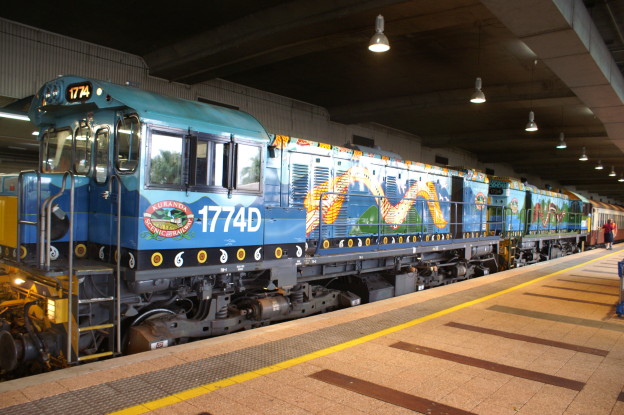6 – Backpacker heaven
Rockhampton – Cairns – Cooktown – Townsville
After a restful night in the Criterion Hotel, beside the Fitzroy River, I went for a wander, passing elegant sandstone buildings, appropriate for a city that is the regional hub for central Queensland.
Tennis great Rod Laver is a Rocky lad. A bronze bust of ‘The Rocket’, courtesy of the city council, sits in Riverside Park, bird droppings tinting his hair. The bust lists his major victories, including two grand slams, Laver being the only player to have achieved that remarkable feat. Eleven councillors felt the need to be included on the plaque, their names occupying nearly half the space.
Mount Archer National Park provides a green backdrop for the city. Public transport would get me halfway there, a bike all the way if I was prepared to ride on the highway. I wasn’t, so I joined Greg and Gail on another bus to coastal Yeppoon, passing Mount Jim Crow National Park, a steep black volcanic plug rising from the plains.
Greg and Gail departed at Yeppoon; I stayed put, heading south alongside Capricorn Coast National Park – a thin strip of land between road and water comprising windswept casuarinas, heath, tussocky grasslands and low rocky headlands.
The day’s surprise was Emu Park Historical Museum. As with most volunteer-run collections, it was packed with memorabilia, and staffed by enthusiastic helpers, pottering about, having fun. Bob gave me a copy of Emu Droppings, the museum’s newsletter. It had a 1915 photo of a steam train arriving at Emu Park station, long since abandoned. The museum had several railway exhibits, including a camp wagon, once housing for men working in remote areas, but now filled with ‘railwayana’.
I read a handout about King O’Malley. Aged 30 and sick with tuberculosis – the disease had already claimed his wife Rosy – O’Malley left America in 1888, hoping Australia’s warmer climate would cure him. He disembarked at nearby Port Alma and was taken to Emu Park, where an Aboriginal man named Coowonga found him sheltering in a cave, weak from his illness.
The story continued: Coowonga fed O’Malley on a diet of oysters, kangaroo meat, Burdekin plums and fish and eventually, over a period of two years, nursed him back to health. Once recovered, O’Malley walked over 2000 km to Adelaide, where his political career began. Although his parents owned a farm south of the American–Canadian border, he claimed to be Canadian by birth. This was important because, as a British subject, he was able to pursue a career in politics.
O’Malley represented Tasmania in the first Australian parliament, ‘fathered’ the establishment of the Commonwealth Bank, promoted the transcontinental railway and took the ‘u’ out of ‘Labour’ in the Australian Labor Party. He twice held the post of Minister for Home Affairs and he drove the first stake to begin the building of Canberra. A temperance advocate, he made himself unpopular by banning alcohol (which he called ‘stagger juice’) in the young capital. With O’Malley’s death in 1953, Australia lost the last of its federation politicians. The alcohol hater would turn in his grave if he knew that one of Canberra’s most popular pubs, King O’Malley’s, bears his name.
Hope you enjoyed the sample.
Till next time, happy travelling
